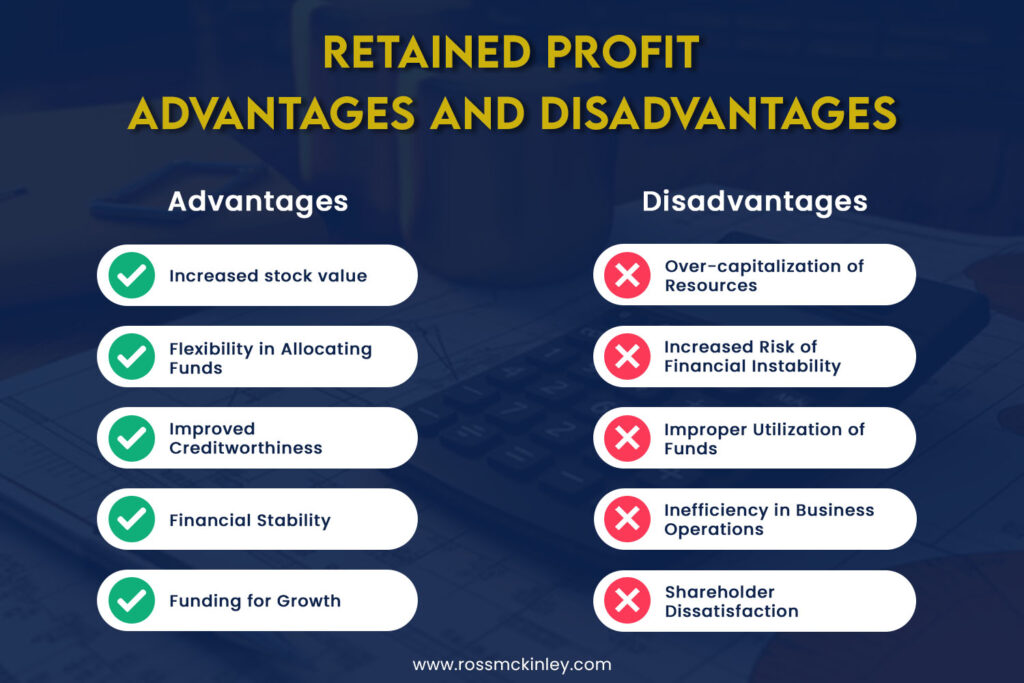
Trade-offs vs Opportunity Costs: Are They Different?
November 12, 2024
Advantages and Disadvantages of a Partnership Business
November 13, 2024Retained Profit Advantages and Disadvantages

When a business makes profits, it is entitled to distribute a certain amount to its stakeholders. Luckily companies can also keep some of the profits as retained earnings to be invested in the company itself.
While retained earnings enable businesses to grow and reduce reliance on external funding, it might also leave shareholders craving for immediate returns.
Retaining profits isn’t always a golden ticket! You must understand the potential advantages and disadvantages to make informed decisions about reinvesting profits for the company’s future.
To help you make an informed decision, we have outlined retained profit advantages and disadvantages.

Table of Contents
What Is Meant By Retained Profit?
Retained profit, also known as retained earnings, is the portion of profit you don’t pay to stakeholders. Instead, you keep it for yourself/company to reinvest or save it for future use. This money appears on the balance sheet as part of the company’s equity. It helps show a company’s financial health and stability, which attracts potential investors.
Retained earnings are important for long-term growth and to deal with economic uncertainties. Keeping profits within the company helps reduce the need for loans or outside funding. Over time, retained profits can grow and provide a reliable source for future investments.
| Advantages | Disadvantages |
| Increased stock valueFlexibility in Allocating FundsImproved CreditworthinessFinancial StabilityFunding for Growth | Over-capitalization of ResourcesIncreased Risk of Financial InstabilityImproper Utilization of FundsInefficiency in Business OperationsShareholder Dissatisfaction |
How to Calculate Retained Profit?
Calculating retained profit occurs over regular periods, such as annually, quarterly, or monthly. Each calculation reflects the company’s performance during that time frame. Things that directly impact your retained earnings are increased sales or unexpected losses.
You can calculate the retained profit by adding the previous term’s retained earnings to the current net income and subtracting dividends. This formula shows that retained earnings depend on both past profits and current income.
A positive retained earning figure indicates accumulated profits that can be reinvested for the growth of the business, or to pay off debt. However, a negative retained earning figure would suggest that the company is incurring more losses than profits probably because of challenges in attaining profitability.
Advantages of Retained Profit
There are several benefits of retained profits. Understanding the impact of retained profit on business growth can empower companies to make strategic decisions. It can enable companies to achieve their goals and rise as market leaders. Let’s have a look at retained profit advantages to understand why it is important for any company.
Increased Stock Value
Retained profit increases a company’s stock value by reinvesting earnings into growth. This improves the company’s overall worth and leads to higher stock prices. Shareholders benefit as the business grows without relying on external funding.
Flexibility in Allocating Funds
Retaining profits allows businesses to reinvest in areas like expansion, new projects, or research. Companies can invest in growth opportunities without requiring external funding, which will make them stand out as they can adapt themselves to modern demands.
Improved Creditworthiness
A high level of retained profit enhances a company’s creditworthiness, making it easier to get loans. Lenders see retained earnings as a sign of financial stability and lower risk, which results in better loan terms and access to credit.
Financial Stability
Retained profits offer financial stability by acting as a reserve for emergencies or future investments. Companies can use these funds to deal with downturns or benefit from new opportunities. This reduces reliance on external funding and ensures sustainable growth.
Funding for Growth
One significant advantage of retained profit is its role as an internal funding source for growth and expansion. Companies can use retained earnings to finance new ventures without taking on debt while maintaining financial stability. Using retained profits for growth supports steady progress and reduces reliance on external financing.
Disadvantages of Retained Profit
There are several drawbacks of retained profits. Market fluctuations can impact investments, and your business may have to bear significant losses leading to a fall in retained earnings. Understand retained profit disadvantages before you finalize your company’s financial strategies.
Over-Capitalization of Resources
Retained profit can lead to over-capitalization if too much is held without purpose. Excess funds can indicate a lack of investment opportunities and reduce shareholder value. This situation also discourages external investors from giving you loans for your business.
Increased Risk of Financial Instability
When companies rely heavily on internal funding, they face increased financial risks. Investments may not always generate expected returns and can lead to potential losses. Furthermore, shifting market conditions can amplify these risks, negatively impacting overall business performance.
Improper Utilization of Funds
You’ll waste your retained profits if you don’t use your funds wisely. Businesses may invest in projects that do not generate returns, leading to financial losses. Ineffective use of retained earnings can badly affect your company’s growth potential.
Inefficiency in Business Operations
Retained profits can create inefficiencies within a company when you don’t utilize the funds. Holding excess profits showcases a company’s poor management or lack of strategic planning. This can prevent the business from maximizing its potential. Moreover, you won’t be able to adapt according to the latest requirements.
Shareholder Dissatisfaction
Retaining profits instead of distributing dividends can lead to shareholder dissatisfaction. Investors may prefer immediate returns rather than waiting for potential future growth. When that doesn’t happen, investors tend to lose confidence in your company.
Conclusion
Retained profits are like the secret sauce in a company’s financial strategy. On one hand, they provide vital funding for growth and help keep the financial ship steady.
While on the other hand, it may lead to over-capitalization of resources. Consider the retained profit advantages and disadvantages and develop strategies that support sustainable growth while minimizing financial risks.
Balancing retained profits with dividends is like sharing your dessert—everyone gets a taste, and nobody leaves hungry. With careful management, companies can use retained earnings to support expansion while maintaining investor confidence.
